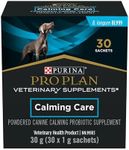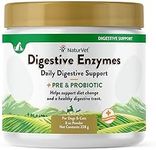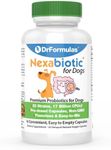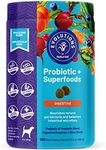Buying Guide for the Best Dog Probiotics
Choosing the right dog probiotics can make a big difference in your pet’s digestive health and overall well-being. Probiotics are beneficial bacteria that help maintain a healthy balance in your dog’s gut, supporting digestion, immune function, and sometimes even mood. When shopping for dog probiotics, it’s important to understand the key features and how they relate to your dog’s specific needs, such as age, size, health conditions, and sensitivities. By focusing on the most important specifications, you can select a product that will be both safe and effective for your furry friend.Type of Probiotic StrainsThe type of probiotic strains refers to the specific kinds of beneficial bacteria included in the supplement. This is important because different strains can have different effects on your dog’s health, such as supporting digestion, reducing diarrhea, or boosting immunity. Some products contain just one or two strains, while others offer a blend of several. If your dog has a specific issue, like sensitive digestion or frequent stomach upsets, look for strains known to help with those problems. For general health, a multi-strain product can offer broader support. Always check that the strains are well-researched for use in dogs.
CFU Count (Colony Forming Units)CFU count measures the number of live, active bacteria in each serving of the probiotic. This is important because a higher CFU count generally means more bacteria are available to benefit your dog’s gut. CFU counts can range from a few million to several billion per serving. For everyday maintenance, a lower CFU count may be enough, but for dogs with digestive issues or after antibiotics, a higher count might be more effective. Choose a CFU level that matches your dog’s health needs and follow the product’s dosing recommendations.
Form (Powder, Chew, Capsule, Liquid)The form of the probiotic refers to how it is given to your dog, such as powder, chewable treats, capsules, or liquid. This matters because some dogs are picky eaters or have trouble swallowing pills. Powders can be mixed with food, chews are often like treats, capsules can be hidden in food, and liquids can be added to meals or water. Pick a form that fits your dog’s preferences and your routine, making it easy to give the supplement consistently.
Additional IngredientsMany dog probiotics include extra ingredients like prebiotics (which feed the good bacteria), vitamins, or flavorings. These can enhance the benefits or make the product more appealing to your dog. However, if your dog has allergies or sensitivities, it’s important to check for potential triggers like chicken, beef, or artificial additives. Choose a product with simple, recognizable ingredients if your dog is sensitive, or look for added nutrients if you want extra health support.
Storage and Shelf StabilityProbiotics are living organisms, so how they are stored can affect their effectiveness. Some need refrigeration, while others are shelf-stable and can be kept at room temperature. Shelf-stable products are more convenient, especially if you travel or want to keep the supplement handy. However, always check the expiration date and storage instructions to ensure the probiotics remain active. Pick a product that fits your lifestyle and storage options.
















